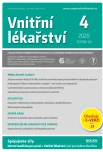Hyperuricemia in renal disease patients
Authors:
Štěpán Bandúr
Authors‘ workplace:
I. interní klinika 3. LF UK a FN Královské Vinohrady Praha
Published in:
Vnitř Lék 2020; 66(4): 259-266
Category:
Differential Diagnosis Column or What You Can Be Asked at a Postgraduate Certification Exam
Overview
Hyperuricemia is a common laboratory finding in different types of patients. Except of those with acute or chronic gout, it is frequently found in patients with metabolic syndrome, patients with malignancies or renal impairment – acute kidney injury (AKI) and chronic kidney disease (CKD). Hyperuricemia might cause renal dysfunction or might be a part of laboratory abnormalities associated with loss of renal function as well. There is also large body of evidence of hyperuricemia as a potential cardiovascular (CV) risk factor, which might even more increase CV risk in CKD patients. Association of asymptomatic hyperuricemia and progression of CKD remaines controversial, as well as indication for hypouricemic treatment in this clinical setting.
Keywords:
Uric acid – acute kidney injury (AKI) – cardiovascular risk – hyperuricemia – chronic kidney disease (CKD)
Sources
1. McCrudden F. Uric Acid: The Chemistry, Physiology, and Pathology of Uric Acid and the Physiologically Important Purine Bodies, With a Discussion of the Metabolism in Gout. New York, NY: Paul Hoeber Medical Books 1905.
2. Maesaka JK, Fishbane S. Regulation of renal urate excretion: a critical review. Am J Kidney Dis 1998; 32: 917–933.
3. Desideri G, Puig JG, Richette P. The management of hyperuricemia with urate deposition. Curr Med Res Opin 2015; 31: (Suppl. 2): 27–32.
4. Shields GE, Beard SM. A Systematic Review of the Economic and Humanistic Burden of Gout. Pharmacoeconomics 2015; 33: 1029–1047.
5. Lee H, Hall A, Nathan N, et al. Mechanisms of implementing public health interventions: a pooled causal mediation analysis of randomised trials. Implement Sci 2018; 13: 42.
6. Oda M, Satta Y, Takenaka O, et al. Loss of urate oxidase activity in hominoids and its evolutionary implications. Mol Biol Evol 2002; 19: 640–653.
7. Voet D, Voet J. Biochemistry. 4. Ed. (s.l.): John Wiley & Sons.
8. Whiteman M, Halliwell B. Protection against peroxynitrite -dependent tyrosine nitration and alpha 1-antiproteinase inactivation by ascorbic acid. A comparison with other biological antioxidants. Free Radic Res 1996; 25: 275–283.
9. Ames BN, Cathcart R, Schwiers E, et al. Uric acid provides an antioxidant defense in humans against oxidant- and radical -caused aging and cancer: a hypothesis. Proc Natl Acad Sci USA 1981; 78: 6858–6862.
10. Wu XW, Muzny DM, Lee CC et al. Two independent mutational events in the loss of urate oxidase during hominoid evolution. J Mol Evol 1992; 34: 78–84.
11. Susumu W, Duk -Hee K, Lili F, et al. Uric Acid, Hominoid Evolution, and the Pathogenesis of Salt -Sensitivity Originally published. Hypertension 2002; 40: 355–360.
12. Keilin J. The biological significance of uric acid and guanine excretion. Biol Rev 1959; 34: 265–296.
13. Conger JD. Acute uric acid nephropathy. Med Clin North Am 1990; 74: 859–871.
14. Seldin DW, Giebisch G (eds). The Kidney, Physiology and Pathophysiology. Philadelphia, Lippincott Williams & Wilkins 2000, 193–222.
15. Roch -Ramel F, Guisan B. Renal Transport of Urate in Humans. News Physiol Sci 1999; 14: 80–84.
16. Rice T, Vogler GP, Perry TS, et al. Heterogeneity in the familial aggregation of fasting serum uric acid level in five North American populations: the Lipid Research Clinics Family Study. Am J Med Genet 1990; 36: 219–225.
17. Köttgen A, Albrecht E, Teumer A, et al. Genome -wide association analyses identify 18 new loci associated with serum urate concentrations. Nat Genet 2013; 45: 145–154.
18. Enomoto A, Kimura H, Chairoungdua A, et al. Molecular identification of a renal urate anion exchanger that regulates blood urate levels. Nature 2002; 417: 447–452.
19. Igarashi T, Sekine T, Sugimura H, et al. Acute renal failure after exercise in a child with renal hypouricaemia. Pediatr Nephrol 1993; 7: 292–293.
20. Richette P, Perez -Ruiz F, Doherty M, et al. Improving cardiovascular and renal outcomes in gout: what should we target? Nat Rev Rheumatol 2014; 10: 654–661.
21. Okafor O. Allopurinol as a therapeutic option in cardiovascular disease. Pharmacol Ther 2017; 172: 139–150.
Labels
Diabetology Endocrinology Internal medicineArticle was published in
Internal Medicine

2020 Issue 4
Most read in this issue
- Liver fibrosis
- Evaluation of surgical risk in patients with liver cirrhosis
- Microscopic polyangiitis
- Hyperuricemia in renal disease patients
